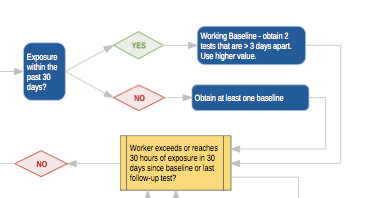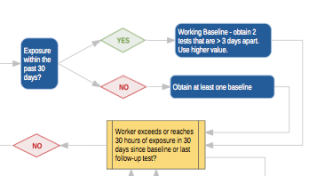MCN and Partners Develop Comprehensive Clinical Tool
As part of our series of continuing education webinars, MCN partnered with the National Farm Medicine Center and Agrisafe Network in March to present the Nuts & Bolts of Cholinesterase Monitoring for Farmers, Ranchers and Agricultural Workers. The webinar – archived on the MCN website – provides a comprehensive overview of cholinesterase monitoring and its application in the primary care setting, including a review of the history of cholinesterase monitoring, best practices for whom and when to test, types of cholinesterase and what to measure, obtaining baselines, the role of the clinician in protecting workers and reporting pesticide exposures.
In conjunction with the webinar, MCN and its partners also unveiled our latest pair of clinical tools – the Cholinesterase Testing Protocol for Health Care Providers and the Cholinesterase Testing Protocol Algorithm. The cholinesterase protocol and algorithm, according to Carolyn Sheridan, RN, BSN, Clinical Director at Agrisafe Network, are helpful, simple tools in a concise format for clinicians to use as guides.
“The algorithm and protocols are straightforward tools to use to manage care,” she said.
Sheridan, along with Matthew Keifer, MD, MPH, Director of the National Farm Medicine Center and with additional support from MCN's Amy K. Liebman, MPA, MA, reviewed seven cholinesterase monitoring protocols to develop a more comprehensive tool.
The protocol and algorithm provide clinicians with practical answers to questions regarding all aspects of the plan of care, including testing, follow-up care and managing patients’ return to work, according to Sheridan.
Experts in environmental and occupational health, pesticides, migrant health and agricultural health and safety peer-reviewed the newly developed tools, which also received the endorsement of MCN’s Environmental and Occupational Health Advisory Committee.
More about Organophosphates, Cholinesterase and ChE Monitoring
Two of the more toxic classes of insecticides in use today – Organophosphates (OP) and N-methyl-carbamates (CM) – were born from the research of German scientist Gerhard Schrader and have similar origins to other toxic nervous gasses he discovered during his research.
The OP and CM classes of insecticides both act to inhibit an important enzyme in the functioning of the nervous system called cholinesterase. Monitoring the levels of cholinesterase in patients working with these chemicals is a way clinicians can help protect workers and diagnose acute overexposure.
The two types of cholinesterase present in the human body are acetylcholinesterase (red blood cell (RBC) cholinesterase – AChE) and butyl cholinesterase (plasma cholinesterase – PChE). The RBC or AChE is generally less susceptible to inhibition from OP exposure and more robust than is PChE, though both should be monitored.
During MCN’s webinar, Dr. Keifer makes the case for cholinesterase monitoring in terms of worker protection, listing the following potential benefits that can result:
- Removing overexposed workers before illness begins
- Identifying failures in worker protection systems
- Raising awareness of hazards of the chemicals monitored
- Diagnosing acute overexposures
- Driving the financial equation toward the use and development of safer chemicals
- Log in to post comments
